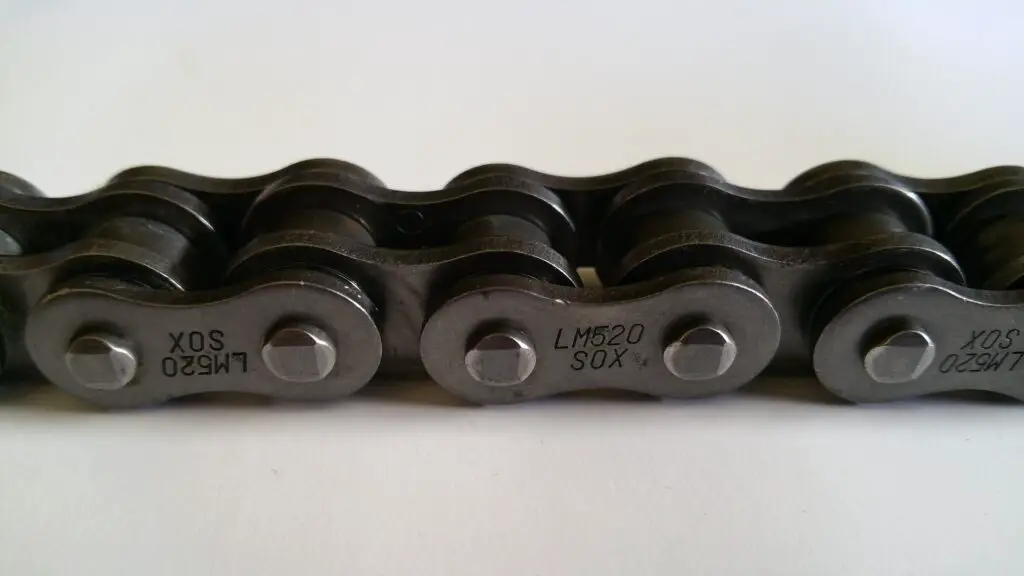Ideally, you won’t need to mess with adding links to a motorcycle chain, because you’ll just purchase chains that are the right length, right? The truth is, you’ll likely want to add or remove chains at some point in the life of your motorcycle.
You can safely add a link to a motorcycle chain. Master clip-on style links and river style links can be added to a motorcycle chain to add some length. As long as you are attaching the new link correctly, with the proper tools, you shouldn’t have any problems.
Of course, there’s a lot of discussion on adding motorcycle links and the conversation doesn’t end here. Keep reading to find out a little more about adding links to your motorcycle chain.

Is it possible to add a link to a motorcycle chain?
It is possible to add a link to a motorcycle chain. Usually, when we talk about adding a link or two, we’re talking about adding a master link to the chain.
While there are some people out there who have basically built new chains by adding links, that’s not what we’ll cover in this video. If you want to build a chain, just make sure you have the experience and tools to do so safely. In general, I recommend buying a chain.
I also recommend buying a chain that is the right length. It’s important to learn how to measure the length of your chain so you can get the right product and not need to add after-market adjustments. I’ll cover size more in the last section of this article.
If you can’t buy the right size for any reason, it’s definitely better to buy a chain that is too long and cut it rather than buying a chain that is too small and adding to it.
Before you cut a chain, check and double check that you are cutting it to the right size, and avoid adding a link altogether.
However, if you need to add a link or two for any reason, know that doing so is possible, though there is a lot of discussion in the motorcycle world as to whether or not that’s the safest decision.
Here’s the problem with adding a master link. When chains break, they most often break at the master link. By adding a second master link, you have two “weakest links” instead of one.
That being said, master links are designed for motorcycle chains, and you already have one on the chain, so it’s not like they are guaranteed to fail.
One way to minimize the risk is to use rivet style links instead of clip-on style, which aren’t as safe. No matter what kind of master link you use, make sure that you install them correctly. This means getting the right size link, putting it in the proper orientation, and securing it with the proper tools.
If you want to add another link or two, make sure you are doing so safely. Also make sure to practice proper chain maintenance and inspect your chain often to make sure the new links still look good after each ride.
How often should you replace the motorcycle chain?
Motorcycle chains don’t last forever. Knowing when to replace your chain can be a difficult call to make, but it’s essential that you replace the chain before it becomes too loose or breaks while you ride, causing more damage and possible harm.
A good rule of thumb is to replace your motorcycle chain after approximately 2,000 miles of riding.
Of course, there are a lot of factors that go into how long your motorcycle chain will last. For example: weather, precipitation, dust, and maintenance habits.
The best way to extend the life of your motorcycle chain is to focus on chain maintenance. This means wiping down the chain after every wet ride, cleaning it and lubing it at least every 300 miles.
While you clean your motorcycle chain, you should be watching for signs of wear and tear. Things to look for are tight spots, stretch, kinks, worn down sprockets, or anything unusual with links in the chain, especially the master link.
If you’ve added links to your chain, it’s often a good idea to mark those added links so that you can keep an eye on them and make sure that they are on correctly.
If your used chain is too tight or too loose, it’s recommended to buy a new chain instead of trying to adjust the old chain. This guarantees that your chain is in top condition and won’t give you any problems when you’re on the road.
One quick note, when you do decide that it’s time to change the chain, make sure to also change the sprockets. If you use a new chain on old sprockets you’re likely to end up with uneven wear.
How do you buy the right motorcycle chain?
Once you decide to replace the chain, the process can feel daunting. How do you make sure that the chain is the right size and type for your bike?
The first thing to do is identify the type of chain your motorcycle uses. Plain roller chains are simple metal chains that aren’t sealed. They are far less common in modern bikes, which have mostly moved to sealed chains.
Within the category of sealed chains you can find O-rings, X-rings, and Y-rings. The letters refer to the type of connection between the links.
Sealed chains come with protective lubrication between links. They are often more durable as the protective seal also helps keep dust and water out.
Whether you are buying a chain or just a link to add, you’ll want to make sure that you know what chain your bike uses so you can get the correct type of link.
Next you’ll need to figure out the size. There are actually a few elements to consider here.
- Pitch=the distance between pins
- Length=often determined by the number of pins
- Tensile strength=load carrying capability
Most motorcycle chains have this information stamped on the side of the links. Your old chain should have all the information you need in order to buy a new one.
How do you know if your chain is the right size?
If you’ve added a chain to your motorcycle and aren’t sure if it’s the right size, there is a way to double check.
First you’ll want to adjust the bike until the chain is on the largest chainring and rear cog. The bike should be long enough that it can make this adjustment properly.
Next, you’ll switch to the smallest chainring. At this setting, the chain should still be tight–with no slack. If your chain can stretch to the largest setting and hold tension at the smallest setting, then you have the size adjusted correctly.
You may still need to adjust the tension slightly, especially after the first few rides as the new chain adjusts and settles.
If you bought the wrong size chain, remember that you can add one or two new links and you can always remove links in order to make the chain smaller. Always add or remove links one at a time to avoid extra work.
